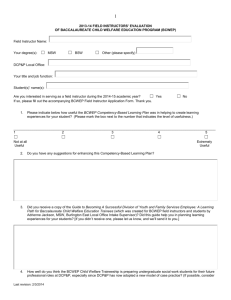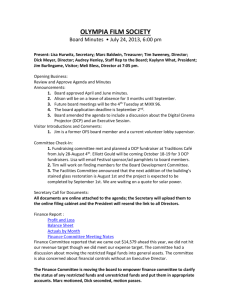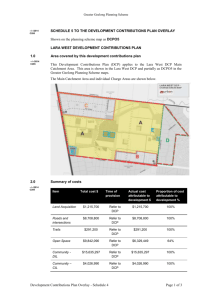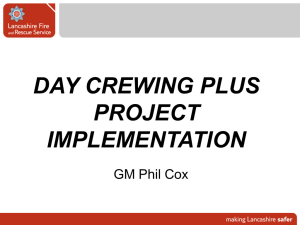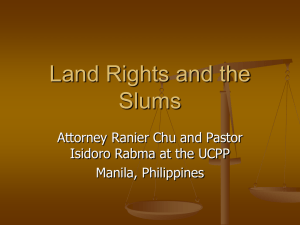TOWN PLANNING SCHEME NO. 3 AMENDMENT NO. 81
advertisement
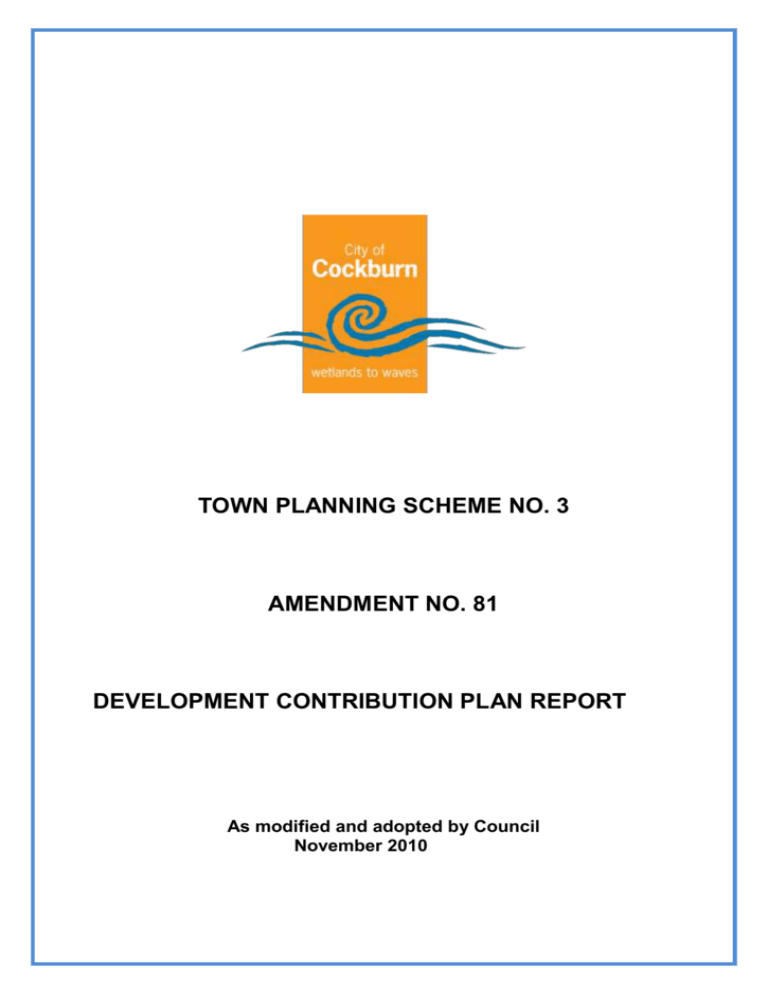
City of Cockburn TOWN PLANNING SCHEME NO. 3 AMENDMENT NO. 81 DEVELOPMENT CONTRIBUTION PLAN REPORT As modified and adopted by Council November 2010 REPORT ON DEVELOPMENT CONTRIBUTION PLAN No 13 This report sets out information relative to proposed Developer Contribution Plan (DCP) No 13 that is the subject of Amendment No 81 to the City of Cockburn Town Planning Scheme No 3. The report included in the Amendment documents sets out general information regarding the amendment and should be read in conjunction with this document which sets out the supporting information including that required under State Planning Policy 3.6 Developer Contributions for Infrastructure. 1. DEVELOPMENT CONTRIBUTION AREA (DCA 13) The development contribution area is shown on sheet 26 of the scheme map as DCA 13 which is part of Amendment No 81. As well as delineating the contribution area, sheet 26 also shows the regional, sub regional and local catchment areas referred to in the DCP to ensure clarity. A copy of sheet 26 of the Scheme Map is included in Appendix No 1. 2. PURPOSE The purpose of the development contribution plan is to; (a) enable the application of development contributions to develop new and the upgrading of existing community infrastructure which is required as a result of increased demand generated by subdivision/development in the development contribution area; (b) provide for the equitable sharing of the costs of infrastructure and administrative items between owners; (c) ensure that cost contributions are reasonably required as a result of the subdivision and development of land in the development contribution area. The Plan for the District is the relevant document which coordinates the timely provision of the community infrastructure items. 3. PERIOD OF THE PLAN It is proposed that DCP 13 operate until 30 June 2031. However the DCP may also be extended for further periods (with or without modification) by subsequent Scheme Amendments. The reason for the time frame is as follows; The community infrastructure items included in the DCP are being planned and provided on the basis of the needs of the ultimate community which will be substantially achieved by 2031. It is fair and equitable that all development that has been taken into account in assessing the need for community infrastructure actually makes a contribution to that infrastructure. A longer operation period will achieve that objective. When preparing the Plan for the District which details the provision of community infrastructure, Council will have confidence that it will be able to meet its commitments to the provision of community infrastructure as the provision of funds through the DCP will be assured. Land owners will be treated equitably regardless of when they develop. When the stated period of operation is reasonably short it is likely that some owners will defer subdividing or developing in a hope of avoiding making a contribution. As much of the land to be subdivided or developed within the City of Cockburn is owned by private owners rather than development companies, this is a real consideration and has the potential to significantly affect the development rate and availability of land in the area. This would be counter productive to State Government objectives of maintaining an adequate supply of developed land and moderating price increases, as well as promoting urban consolidation which is a clear priority under the State Government’s Directions 2031 and Beyond Strategic Plan for Perth and Peel. The adoption of a short time frame creates constant uncertainty for landowners and the Council as to the possible outcomes of the Scheme Amendment process required to change the period of operation. Adoption of a longer time frame removes that uncertainty. In this regard it is noted that the average time frame to amend a Town Planning Scheme is 12 to 18 months and accordingly to ensure continuity of the DCP with a short period of operation, an amendment would need to be initiated soon after the gazettal of the DCP and well in advance of the expiry date. This is an unnecessary and time consuming administrative burden for both the local government and the Department of Planning. It is also noted that being one of the first amendments to introduce community infrastructure contributions on this scale, it may be several months before Amendment No 81 is gazetted. The City has seven existing DCP’s which have been operating for some 12 years. Over that period, development within the DCP areas has proceeded to varying degrees. Only DCA 3 Gaebler Road is well advanced and could be wound up within the next few years whilst others are less than 50% complete and could be another 10 years or so before realising full development. Based on the experience with existing DCP’s administered by the City, a 20 year period of operation for DCP 13 is considered justified. Given the period over which the community infrastructure is to be provided and that the timing of the infrastructure items takes into account the anticipated development rates and patterns in each catchment area, all residents will benefit from the payment of the contribution towards the provision of the community infrastructure items and the provision of the infrastructure item. The period reflects a widely accepted planning horizon. In this regard it is consistent with the population/dwelling forecast horizon undertaken by id Consulting for the City, State Government forecasts and the State Government’s blue print for development – Directions 2031. The use of 2031 (20 years) as the period of operation as opposed to 2021 (10 years) will not disadvantage developers as the average per dwelling cost contribution is the same regardless of which time horizon is selected as shown in the following calculations. Average DCA cost contribution for each new dwelling based on 2021 time horizon Current - 2009 Forecast - 2021 Forecast - 2031 Dwellings(Du’s) (Note 2) Increase in Du’s for period 32,886 46,228 52,442 13,342 6,214 % Contribution of total cost 62.710 25.441 11.849 Distributed total estimated Cost of Infrastructure ($159,882,060) Average DCA cost contribution per new dwelling 40,660,330 Beyond time frame $3,047 Average DCA cost contribution for each new dwelling based on 2031 time horizon Dwellings(Du’s) (Note 2) Current - 2009 Forecast - 2031 32,886 52,442 Increase Du’s period 19,556 in for % Contribution of total cost 62.710 37.290 Distributed total estimated cost of Infrastructure ($159,882,060) Average DCA cost contribution per new dwelling 59,597,646 (Note 3) $3,047 The reason the average DCA contributions are the same for both time horizons is due to the fact that if the time period is reduced then, as per SPP 3.6, you also need to adjust the contribution calculation to take into account future dwellings. The above shows that whilst the average contribution per dwelling remains the same, the amount raised by the City will be some $18,937,316 (Note 1) less if the 2021 time horizon is adopted. This is the amount that is attributable to the estimated 6,214 dwellings that would be developed between 2021 and 2031 and the DCA period is not extended. As previously stated, a reduced time horizon will create unnecessary uncertainty for both developers and Council. In the event that the period of operation is reduced to 2021 and the DCA is not extended through subsequent amendments to the Scheme, the gap in revenue of $18,937,316(Note 1) will fall to current landowners to fund which is neither fair nor equitable, particularly given the need and scope of the various community infrastructure items has been determined on the ultimate number of dwellings and resultant population. Note 1 Figures used above based on draft cost contribution schedule as initiated February 2010 Note 2 As estimated by id Consulting Note 3 Differs marginally from detailed cost allocation due to those costs reflecting Regional, Subregional and local allocations 4. OPERATION OF THE DCP DCP 13 has been prepared in accordance with State Planning Policy 3.6 Development Contributions for Infrastructure and will come into effect on the date of gazettal of Amendment No 81. Clause 5.4 of SPP 3.6 states that in the interim, where a local government has received consent to advertise a DCP, land within the DCA area will be considered to be subject to the requirements of the DCP and contributions may be calculated but the City will not be able to collect payment until Amendment No 81 is gazetted. The Department of Planning have advised, since the endorsement of the proposed Amendment 81 by Council, that arrangements to pay contributions should be made for proposals. Therefore it is proposed that the City require the inclusion of conditions and explanatory advice notes on subdivision and development approvals noting that DCP13 is under consideration. This will ensure that at subsequent stages, for example subdivision clearance or building licence, that landowners are aware of their liability for contributions should DCP 13 be gazetted. Legal agreements will be required to secure this. Following gazettal of Amendment No. 81, a condition will be included on subdivision and development approvals requiring payment of the DCA contribution which would be at the time of seeking clearance to a Deposited Plan or Strata Plan in the case of subdivision or at the time of issuing a building licence where there is no prior subdivision or subdivision is not proposed. This is consistent with Clause 6.3.5 of the Scheme. 5. APPLICATION REQUIRMENTS Where a subdivision, strata subdivision including both built and/or strata lots or a development application is lodged for the extension of an existing land use is lodged which related to land which this DCP applies, Council shall take the provisions of the DCP into account in making a recommendation on or determining that application. 6. COMPLIANCE WITH THE PRINCIPLES UNDERLYING CONTRIBUTIONS AS SET OUT IN CLAUSE 5.2 OF SPP 3.6 DEVELOPMENT 1. Need and the nexus The need for each item of infrastructure included in the DCP and the connection between the development and the demand created by new development within the City is clearly set out in the individual Infrastructure Item sheets set out in Appendix 2 of this report. 2. Transparency The following has been adopted to ensure transparency in the method for calculating and applying the contribution and that the DCP application is simple to understand and administer; The contribution is in respect to new dwellings to be created between 2009 and 2031. The number of existing and future dwellings was independently prepared by id Consulting which specialises in demographic forecasting. Appendix 3 provides details of the forecast dwellings. In some cases suburbs such as Bibra Lake were manually split between Bibra east and Bibra west (St Pauls) by the City. Details of the forecast can be accessed from www.id.com.au or through a link on the City’s web site. The assessment of the regional, sub-regional and local catchments contained in Appendix 4 clearly shows the number of existing and future dwellings and expresses the future dwellings for each suburb as a percentage of the total forecast dwellings to ensure that the cost of each infrastructure item is equitably apportioned according to the growth potential in each suburb. Sheet 26 of the Scheme Map clearly shows the regional, sub-regional and local catchment areas ( Appendix 1). The location of infrastructure items included in the DCP is clearly shown on the Community Infrastructure Facilities Map (Appendix 5 – Plan 1) and the Bicycle Network Plan (Appendix 5 - Plan 2 ). The Community Infrastructure Cost Contribution Schedule for DCA 13 (Appendix 6) clearly shows the existing number of dwellings for each Infrastructure item to ensure that it is clear that future dwellings are only paying for the cost attributable to future development and not existing dwellings. Calculation of an owner’s contribution will be based on the number of new dwellings/lots that can be created through the relevant subdivision/development application process. The number of new dwellings/lots is then multiplied by the applicable rate for the suburb in which the land is situated. This is the rate shown on the Community Infrastructure Cost Contribution Schedule for DCA 13 (Appendix 6). The approach is simple to understand particularly for landowners who wish to determine their obligations. It is also easily assessed and administered by officers. 3. Equity The development contribution is to be calculated on the basis of the number of dwellings/lots that can be created through the subdivision/development application process thus ensuring that each owners contribution is assessed on a clear and consistent basis and thus reflective of the relative need generated by a particular development. The plan does not make a distinction between Greenfield and Infill/revitalisation residential development. 4. Certainty The DCP and Community Infrastructure Contribution Schedule for DCA 13 clearly set out the items to which subdivision/development in a particular suburb is making a contribution to. Internal accounting will then allocate each landowners contribution to each infrastructure item for the respective suburb on a proportional value basis of the infrastructure items. To provide certainty on the cost of the infrastructure items, the DCP provides that the cost of each infrastructure item is to be reviewed at least annually to reflect changes in funding and revenue sources and indexed based on the Building Cost Index or other appropriate index as approved by an appropriately qualified independent person. 5. Efficiency Development contributions reflect the whole of life capital cost, but excludes running costs. 6. Consistency The development contributions for DCA 13 will be uniformly applied across the whole DCA area on a per dwelling basis which reflects the regional, subregional and local facilities to be provided to service each particular area. The contribution will be levied on subdivision/development or the extension of an existing use in accordance with clause 6.3.5 of the Scheme ensuring that whatever form of development is contemplated, the owner/developer will make an appropriate contribution. 7. Right of consultation and arbitration DCA 13 provisions will be advertised through Amendment No 81 thus satisfying the requirement to consult with landowners and developers on the manner in which the development contributions are determined. Clause 6.3.4 (d)(ii) of the Scheme provides that an owner may request that any estimate contained in a DCP be independently certified by an appropriately qualified person. Clause 6.3.11(a) of the Scheme provides that any dispute between an owner and the local government in respect to a cost contribution is to be resolved by arbitration. 8. Accountability The costs for each infrastructure item are to be reviewed annually and the DCP updated accordingly. The updated DCP will be available on the City’s web site and owners can request the review of any cost in accordance with clause 6.3.4(d)(ii) and have a dispute in respect to the required contribution determined through arbitration in accordance with clause 6.3.11(a) of the Scheme. A Statement of Accounts showing all revenue and expenditure for the DCP is to be prepared for each financial year and audited by the City’s auditors. The audited statements will be available on the City’s web site. 7. COMPLIANCE WITH THE PROCESS FOR DETERMINING DEVELOPMENT CONTRIBUTIONS AS SET OUT IN CLAUSE 5.5 OF SPP 3.6 The matters of need and nexus are dealt with above and in detail in Appendix 2. Other matters are addressed below. Catchment Areas The catchment areas served by the infrastructure items have been divided into either Regional, Sub -Regional or local depending on the nature of the facility. The catchments areas are shown on Sheet 26 of the Scheme Map. Regional uses are generally specialised higher order uses and because people are prepared to travel reasonable distances to these facilities, they serve the whole of the City. Accordingly there is generally only one such facility provided within the City. Regional uses included in the DCP are as follows; Coogee Beach Surf Club Wetlands Education Centre/Native Arc Cockburn Central Recreation and Aquatic Centre Cockburn Central Community Facilities Visko Park Bowling and Recreation Club Coogee Golf Complex Bibra Lake Management Plan Activities Atwell Oval Facilities upgrade Sub-regional uses are still high order activities but are provided on the basis of the western and eastern residential areas. Accordingly these infrastructure items are provided in both the eastern and western residential areas. Items considered to be of sub-regional significance are as follows; Sub Regional - East Cockburn Central Library and Community Facilities Cockburn Central Playing Fields Anning Park Tennis Cockburn Central Heritage Park Bicycle Network - East Sub Regional - West North Coogee Foreshore Management Plan proposals Seniors and Lifelong Learning Centre Beale Park Sports Facilities Western Suburbs Skate Park Bicycle Network – West Dixon Reserve/Wally Hagen Local uses are those that the community generally expects to be provided within their suburb and hence there are numerous similar facilities provide throughout the City. Local items included in the DCP are as follows; Lakelands Reserve Clubrooms Southwell Community Centre Hammond Park Recreation Facility Frankland Reserve Recreation and Community Facility Munster Recreation Facility Cost of the infrastructure item The source of the cost is noted on each of the detailed sheets for each infrastructure item. For some items plans are well advanced and detailed cost estimates have been prepared by either the architect or a Quantity Surveyor. For others, costs estimates have been based on preliminary concept plans and will need to be reviewed when detailed briefs and plans have been prepared. In a small number of cases the costs have been based on that of constructing similar facilities. This is also generally for facilities that are to be provided later in the program. As provided for in the DCP, the cost of the infrastructure item will be reviewed at least annually. If during the year more detailed costings have been prepared then these would be adopted in preference to broad based estimates. In all other instances the cost estimates will be adjusted to reflect changes in funding and revenue sources that may have been secured and the cost indexed based on the Building Cost Index or other appropriate index as approved by an appropriately qualified independent person. A Community Infrastructure Plan to be prepared The City has adopted specific Strategic Plans which detail the need for community infrastructure items to service the ultimate population of the City. The relevant documents are as follows; Bibra Lake Landscape, Recreation and Environmental Management Plan, Bicycle Network and Footpath Plan, Sport and Recreation Plan (2010) Library Services Strategic Plan (2007) In addition, information is provided in the Plan for the District. A Capital Infrastructure Plan to be prepared. The Plan for the District 2010-2020 which was adopted by Council in June 2010, identifies community infrastructure to be provided within the City, details the time program for delivery of the facilities and identifies general sources of funds. As most of the infrastructure items are to be provided within the next 10 years, the Plan for the District satisfies the requirement for a Capital Infrastructure Plan. Projected growth figures for the catchment areas The number of existing and future dwellings for the period 2009 to 2031 was independently prepared for the City by id Consulting which specialises in demographic forecasting. Appendix 3 provides details of the forecast dwellings. In some cases suburbs such as Bibra Lake were manually split between Bibra east and Bibra west (St Pauls) by the City to satisfy the allocation of local catchment items. The forecast information can be accessed via a link on the City’s web site (About Cockburn) or directly through the id website (www.id.com.au). Details of existing and future dwelling numbers for regional, sub-regional and local catchments is clearly shown in Appendix 4. Methodology for determining the proportion of cost for infrastructure to be attributed to future growth rather than existing areas. The apportionment of the cost of providing the infrastructure items between existing development and future development has been based on the number of existing and future dwellings. The apportionment of the cost of providing community infrastructure to existing dwellings is clearly identified on the Community Infrastructure Cost Contribution Schedule for DCA 13 (Appendix 6) with the balance of the cost being proportionally distributed between the various suburbs based on the potential of each. The apportionment of the contributions in respect to new dwellings has been calculated for each catchment level, that is, regional, sub regional and local (see Appendix 4). 8. ITEMS INCLUDED IN THE DCP i) The following infrastructure items are included in the DCP; Regional Facilities - All suburbs Coogee Beach Surf Club Wetlands Education Centre/Native Arc Cockburn Central Recreation and Aquatic Centre Cockburn Central Community Facilities Visko Park Bowling and Recreation Club Coogee Golf Complex Bibra Lake Management Plan Activities Atwell Oval facilities upgrade Sub Regional - Eastern Suburbs Cockburn Central Library and Community Facilities Cockburn Central Playing Fields Anning Park Tennis Cockburn Central Heritage Park Bicycle Network - East Sub Regional - Western Suburbs North Coogee Foreshore Management Plan Proposals Seniors and Lifelong Learning Centre Beale Park Sports Facilities Western Suburbs Skate Park Bicycle Network – West Dixon Reserve/Wally Hagen Facility Development Local - Specific Suburbs Lakelands Reserve Southwell Community Centre Hammond Park Recreation Facility Frankland Reserve Recreation and Community Facility Munster Recreation Facility The location of infrastructure items included in the DCP is clearly shown on the Community Infrastructure Facilities Map (Appendix 5 – Plan 1) and the Bicycle Network Plan (Appendix 5 Plan 2). The basis for the inclusion of each item in the DCP is contained on the specific sheet for each item in Appendix 2. The cost of infrastructure includes all the initial capital costs associated with the provision of the infrastructure item and excludes ongoing maintenance and operating costs of the infrastructure. The costs can include items such as the cost of land acquisition, planning, design and approvals, clearing permits, clearing works, offset works, site works, servicing infrastructure, construction of the facility including design, tendering and project management, associated landscaping, parking and access arrangements. ii) The following Administration costs are included in the DCP; Cost to prepare the Development Contribution plan and administer it for the period of operation (including legal expenses, valuation fees, cost of design and costs estimates, proportion of staff salaries, computer software and/or hardware required for the purpose of administering the plan and audit fees). Cost to prepare and undertake an annual review of cost estimates including the costs for appropriately qualified independent persons. Costs to prepare and update the Community Infrastructure Cost Contribution Schedule. It was initially proposed to provide an estimate of the administration costs following the advertising of Amendment No 81. Administration of development contribution plans can be complicated and time consuming. This plan includes a number of infrastructure items, all of which will require individual accounts to be maintained, reviewed and submitted for annual auditing. On reflection, it would be quite difficult to provide a realistic estimate for some of these costs at this early stage. Therefore it is now considered prudent that over the first few years of the operation of the DCP, City officers record the time and cost spent administering the DCP be recorded for input into the first review of the plan. Initially, the administration cost in the updated schedule for the proposed plan will represent the salary package for the officer responsible for administering this DCP. Council’s Plan for the District notes the future staffing needs of the Strategic Planning business unit to include a Development Contributions Planner from 2012/13. This recognises that the administration of a Developer Contribution Plan of this scale cannot be accommodated with the current and projected workload the team has. The City’s existing Developer Contribution Plans are administered by the Coordinator Strategic Planning and officers from the City’s Finance team. The salary package is shown in the updated schedule for the proposed plan. This cost is split between each suburb, not equally, but on the average demand they generate for facilities. For example, Leeming has a very small amount of growth (24 lots) and the demand average on facilities is 0.123% resulting in an administration fee of $99.32 for Leeming as a suburb (or $4.14 per dwelling). Success, which has a higher growth proposed (1809 lots) and generates a demand average of 9.665% resulting in an administration fee of $7,804.49 for Success as a suburb (or $4.32 per dwelling). iii) Cost apportionment The apportionment of the costs for regional, sub regional and local infrastructure items to each suburb can be seen on the Cost Contribution Schedule included in Appendix 2. 9. REVIEWS The Development Contribution Plan will be reviewed when considered appropriate, though not exceeding a period of five years duration, having regard to the rate of development in the area since the last review and the degree of development potential still existing. The list of infrastructure items will be reviewed at the time of adopting the Plan of the District to ensure the list of items aligns. Adding or deleting items from the Plan for the District will result in the need for an amendment to TPS No 3 to make the necessary changes to DCP No 13. The estimated cost of infrastructure items shown on the Cost Contribution Schedule will be reviewed at least annually to reflect changes in funding and revenue sources and indexed based on the Building Cost Index or other appropriate index as approved by the qualified person undertaking the certification of costs in accordance with the provisions of DCP No 13.

